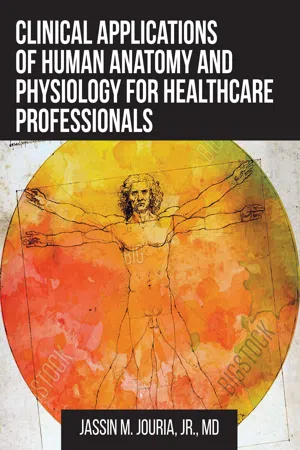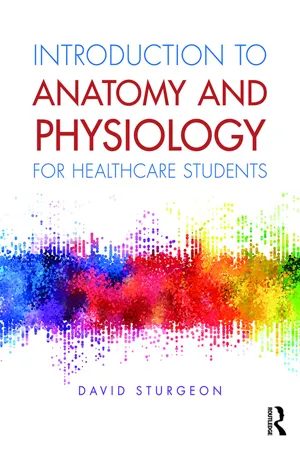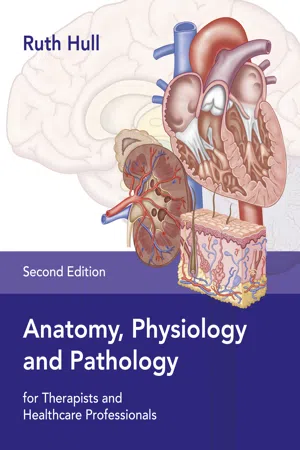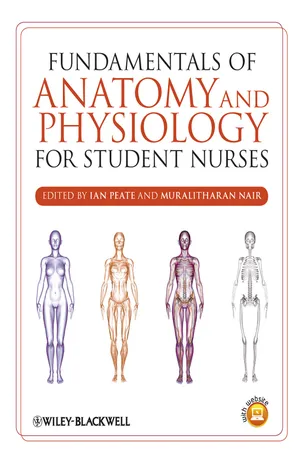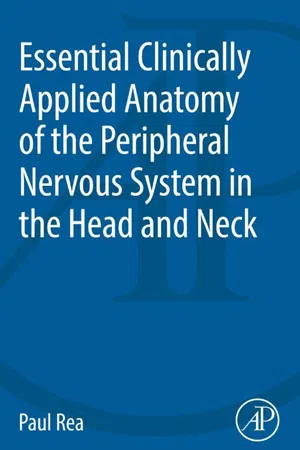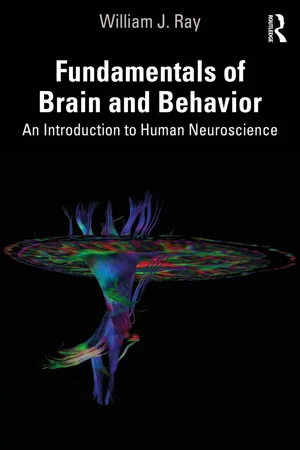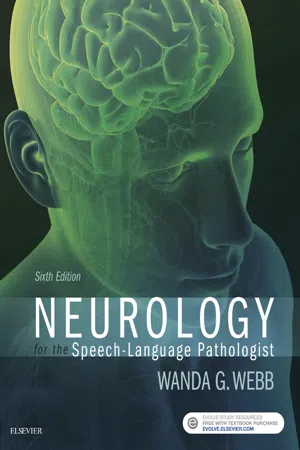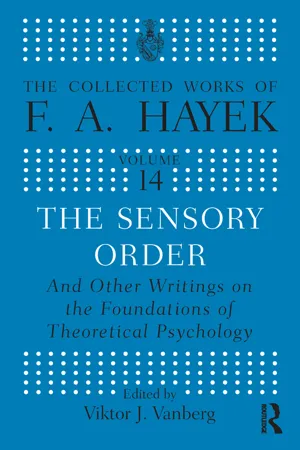Psychology
Nervous System
The nervous system is a complex network of nerves and cells that transmit signals between different parts of the body. It is responsible for coordinating and controlling bodily functions and processes, as well as responding to internal and external stimuli. The nervous system is divided into the central nervous system (CNS) and the peripheral nervous system (PNS), both of which play crucial roles in human behavior and experience.
Written by Perlego with AI-assistance
Related key terms
12 Key excerpts on "Nervous System"
- Jassin M. Jouria(Author)
- 2018(Publication Date)
- BrownWalker Press(Publisher)
In a macroscopic overview, the Nervous System is composed of two divisions: the central Nervous System, known as the CNS, and the peripheral Nervous System, known as the PNS. The central Nervous System is comprised of the brain and the spinal cord. The peripheral Nervous System is composed of paired nerves: 12 cranial nerves and 31 pairs of spinal nerves. The peripheral Nervous System encompasses nerve pathways found outside of the brain and spinal cord or emerging from the spinal cord and making their way through all parts of the body. The peripheral Nervous System also includes the autonomic Nervous System, otherwise known as the ANS.The Nervous System provides four basic responsibilities for function and movement, as well as a massive number of both external and internal sensations and responses in the body.• The central Nervous System of the brain and spinal cord provides a unique communication network; from a single nerve found in the tips of a finger to the bottom of our feet (and all aspects of the peripheral Nervous System) to various areas of the brain. These networks trigger not only sensations and stimulus, but specific responses to them.• Various aspects of the Nervous System transmit information, instructions, or stimulants from both internal and external environments throughout a variety of pathways (sensory or afferent).• Our Nervous System is constantly processing and assimilating, assessing, and analyzing data or information received from either the brain, spinal cord, or other nerve pathways in order to determine specific responses.• Our Nervous System also utilizes a variety of Nervous System pathways – including motor and afferent – to send and receive information to modify, promote, cease, or control certain activities of effector organs throughout the body.The Nervous System, at its most basic and simple definition, receives, analyzes, and responds to data. Millions of sensory receptors are located throughout the body, inside and out. Information sent to the brain from these sensory receptors is defined as sensory input . As the brain analyzes this input, it processes or assesses that data, known as integration or interpretation. Finally, the Nervous System triggers a response. This is known as motor output- David Sturgeon(Author)
- 2018(Publication Date)
- Routledge(Publisher)
12 Nervous SystemContents
- Central Nervous System
- Peripheral Nervous System
- Motor and sensory nerves
- Neurons
- Myelin
- Action potentials
- Synapses and neurotransmitters
- Glial cells
- Microglia, ependymal cells, satellite cells and Schwann cells
- Neuron damage
- Pain transmission
- Acute and chronic pain
- Nociception
- Reflexes
- Special senses
- Sound and balance
- Sight
- Brainstem
- Midbrain and reticular formation
- Cerebellum
- Diencephalon
- Hypothalamus and pituitary gland
- Epithalamus and pineal gland
- Limbic system
- Fornix and amygdala
- Cingulpate gyrus and mammillary bodies
- Olfactory bulbs
- Corpus callosum and hemispheric lateralisation
- Split-brain
- Cerebrum
- Primary motor cortex
- Parietal lobe
- Phantom limb pain
- Sensory association area
- Occipital lobe
- Temporal lobe
- Stroke
- Meninges
- Pia mater and cerebrospinal fluid
- Chapter 12: Test yourself
- Notes
Central Nervous System
Figure 12.1 Spinal nerves and cauda equina.In Chapter 3 , we observed how the body strives to maintain a stable internal environment (homeostasis) despite constant internal and external variation and disturbance. The Nervous System is fundamental to this process and, together with the endocrine system (see Chapter 13 ), detects, responds to and regulates changes inside and outside the body. However, it is much more sophisticated than the simple ‘sensor + integrator + effector’ mechanisms that we have observed so far, and the Nervous System is also responsible for sensory perception, voluntary movements, decision-making, personality, memory and emotion. The endocrine system also plays an important role in determining and regulating these qualities and activities but it is the Nervous System that provides the primary means of communication via an integrated collection of nerve cells (neurons). However, before we look at neurons in more detail, it is important to understand how the Nervous System is organised. Broadly speaking, it is divided into two parts: the central Nervous System (CNS) and the peripheral Nervous System (not to be confused with the parasympathetic Nervous System – see below). The CNS consists of the brain and the spinal cord which are attached to one another at the base of the brainstem (remember that there is a hole in the underside of the cranium called the foramen magnum – see Chapter 4 ). We will look at the brain in more detail later in the chapter and, for now, it is enough to say that it controls and coordinates conscious and unconscious thoughts and actions. The spinal cord is essentially a cylinder of nervous tissue that conveys messages to and from the brain and the body as a whole. It measures 43–45 cm in length and extends from just above the first cervical vertebrae (C1) to the lower border of lumber vertebrae 1 (L1). Below this point, the spinal nerves fan-out as the cauda equina (Latin for ‘horse tail’) through the remaining lumber, sacral and coccygeal vertebrae (Figure 12.1- eBook - ePub
Fundamentals of Children and Young People's Anatomy and Physiology
A Textbook for Nursing and Healthcare Students
- Ian Peate, Elizabeth Gormley-Fleming, Ian Peate, Elizabeth Gormley-Fleming(Authors)
- 2021(Publication Date)
- Wiley-Blackwell(Publisher)
The Nervous System is a complex system that interacts with all body systems to maintain homeostasis in conjunction with the endocrine system. It controls many of these systems through a complex communication system, and the major functions can be summarised as follows:- Orientates us to internal and external environment, such as pain (internal) and seeing danger (external).
- Coordinates and maintains homeostasis of body activities.
- Assimilates experiences and information, through memory, learning, intelligence and dreaming.
- Development of instinctual information at birth.
Organisation of the Nervous System
It is necessary to understand the complexity and organisation of the Nervous System by deconstructing its component parts (Figure 15.1 ). Each component part is intimately connected through a network of neurones (nerves) and supportive neuroglia (nerve fibres). The Nervous System can be divided into the central Nervous System (CNS) and peripheral Nervous System (PNS). Anatomically, the CNS incorporates the:- brain;
- spinal cord.
The PNS includes the:Organisation of the Nervous System.Figure 15.1- cranial nerves;
- spinal nerves;
- sensory (afferent) neurones;
- motor (efferent) neurones;
- somatic Nervous System (voluntary);
- autonomic Nervous System (involuntary):
- sympathetic;
- parasympathetic.
Cellular structure of the Nervous System
The cellular building blocks of the Nervous System are the highly specialised neurones and neuroglia. Neurones are the primary transmission and communication cells, whilst neuroglia cells perform a supportive role.Neurones
There are an estimated 100 billion neurones in the adult human brain. Neurones consist of an axon, dendrites and a cell body (Figure 15.2 ). Their main function is the transmission of electrical impulses when stimulated.- Axon: A collection of axons forms a nerve. Axon length varies in the Nervous System from microscopic to 1 m in an adult. Peripherally, axons can branch off to form an axon collateral (Figure 15.2
- eBook - ePub
- Patricia Barnes-Svarney, Thomas E. Svarney(Authors)
- 2016(Publication Date)
- Visible Ink Press(Publisher)
INTRODUCTION What are the functions of the Nervous System?The Nervous System is one of the major regulatory systems of the body maintaining homeostasis. Its functions are to: 1) monitor the body’s internal and external environments; 2) integrate sensory information; and 3) direct or coordinate the responses of other organ systems to the sensory input.What are the two subsystems of the Nervous System?The Nervous System is divided into the central Nervous System and the peripheral Nervous System. The central Nervous System consists of the brain and spinal cord, while the peripheral Nervous System consists of all the nerve tissue in the body, excluding the brain and spinal cord. Communication between the central Nervous System and the rest of the body is via the peripheral Nervous System. Specialized cells of the peripheral Nervous System allow communication between the two systems.What are the cells in the Nervous System?There are approximately twenty billion nerve cells—called neurons—in the Nervous System. Neurons have a very limited capacity for regeneration. In general, they neither replicate themselves nor repair themselves. Although highly debated, some scientists suggest that there are a few small concentrations of neuronal stem cells that remain in adults that can produce a limited number of new neurons. They are also working on possible future treatments that will allow adult human neurons to regenerate, but such discoveries are still in their infancy.What are the two types of cells found in the peripheral Nervous System?The peripheral Nervous System consists of afferent or sensory neurons and efferent or motor neurons. The afferent nerve cells (from the Latin ad, meaning “toward,” and ferre, meaning “to bring”) carry sensory information from the peripheral to the central Nervous System. They have their cell bodies in ganglia and send a process into the central Nervous System. The efferent nerve cells (from the Latin ex, meaning “away from,” and ferre, - eBook - ePub
Mental Life
An Introduction to Psychology
- Beatrice Edgell(Author)
- 2014(Publication Date)
- Psychology Press(Publisher)
CHAPTER III THE BUILD AND FUNCTIONS OF THE Nervous SystemWE may regard the Nervous System as representing the unity of the body, bringing its different parts and organs into relation with one another. (See Fig. 1 .)In man the Nervous System is made up of two parts: (1) the Central Nervous System, and (2) the Peripheral Nervous System. The first part consists of the brain within the skull and the spinal cord running through the spinal canal in the vertebral column. The second system consists of the Cerebro-spinal (Somatic) nerves and the Autonomic (Visceral) nerves. The latter comprises (a ) nerves right and left of the vertebral column on the ventral side, (b ) ganglia, or collections of nerve cells, in connexion with the viscera, i.e. circulatory, respiratory, digestive, and reproductive organs.The nerves connected with the exterior sensory receptors and those which are connected with the voluntary muscles belong to the Somatic group. The nerves belonging to the involuntary or smooth muscles carrying out movements in the interior of the body belong to the Autonomic system. Briefly, we may say the Somatic nerves are concerned with the reception of stimulation from the external world and with voluntary response thereto, while the Autonomic or Sympathetic system is concerned with the vital functions of the body. Though anatomically connected with the nerves of the spinal cord, the Autonomic system is to some extent capable of functioning independently ; hence its name, Autonomic.THE STRUCTURE OF THE Nervous System(i) General Plan . —The simplest picture which we can form of a mechanism which can receive and respond to stimulation is that of a single cell having a contractile process.FIG . 1.—GENERAL VIEW OF THE Nervous System , SHOWING BRAIN, CORD , AND NERVEG (from Martin’s “Human Body”)This fragment of specialized protoplasm, with its nucleus, is capable of being excited by its environment, e.g. irritated by contact, and of responding to this excitation by contraction of its process. It can also respond in the same manner to changes within its own economy. - eBook - ePub
- Ruth Hull(Author)
- 2021(Publication Date)
- Lotus Publishing(Publisher)
6 The Nervous System IntroductionAir particles vibrate and we hear words, poetry, even music. Waves of light bend to form colours, shapes and images. Simple molecules are transformed into smells or tastes that remind us of our childhood – that can make us laugh or cry.All of these sensations, thoughts and emotions are created in one system of our bodies – the Nervous System. It is a system that gives us not only a sense of who, what and where we are, but also enables us to survive and to change the environment in which we live.The study of the Nervous System is called neurology , and in this chapter we will take a look at how this system is able to control all the other systems of our body and help us control our environment.Student objectives By the end of this chapter you will be able to:• Describe the functions of the Nervous System• Describe the organisation of the Nervous System• Identify the different types of neurons• Describe the structure of a motor neuron• Describe the structure and function of the brain• Identify the cranial nerves• Describe the structure and function of the spinal cord• Identify the spinal nerves and plexuses• Describe the structure and function of the sense organs: eyes, ears, nose and mouth• Identify the common pathologies of the Nervous System.Functions of the Nervous SystemThe Nervous System is made up of millions of nerve cells that all communicate with one another to control the body and maintain homeostasis. These cells detect what is happening both inside and outside the body, interpret these happenings and cause a response. Basically, the Nervous System has three functions: sensory, integrative and motor.Infobox Anatomy and physiology in perspectiveYour Nervous System is not alone in controlling your body and maintaining homeostasis. It works closely with a second control system called the endocrine system, which secretes hormones. One of the main differences between the two systems is that the Nervous System can respond rapidly to stimuli and works faster than the endocrine system. You will learn more about the endocrine system in chapter 7 - Ian Peate, Muralitharan Nair, Ian Peate, Muralitharan Nair(Authors)
- 2011(Publication Date)
- Wiley-Blackwell(Publisher)
The Nervous System is a major communicating and control system within the body. It works with the endocrine system to control many body functions. The Nervous System provides a rapid and short acting response and the endocrine system provides a slower but often more sustained response. The two systems work together to maintain homeostasis.The Nervous System interacts with all of the systems of the body. This system is large and complex. In order to facilitate understanding of the Nervous System it has to be divided into smaller functional and anatomical parts. This chapter outlines the divisions of the Nervous System; it discusses the structure and function of the Nervous System and how it influences other structures of the body. Having such an important role in maintaining homeostasis, the Nervous System possesses additional protection and that too will be investigated.Organisation of the Nervous SystemThe Nervous System can be divided into two parts: the central Nervous System and the peripheral Nervous System. The central Nervous System consists of the brain and spinal cord and is the control and integration centre for many body functions.The peripheral Nervous System carries sensory information to the central Nervous System and motor information out of the central Nervous System. The direction of information flow to and from the Nervous System is important and is shown in Figure 6.1 .Figure 6.1 Organisation of the Nervous SystemSensory division of the peripheral Nervous SystemSensory information is gathered from both inside and outside of the body. This sensory input is delivered to the central Nervous System via the peripheral nerves. Sensory nerve fibres are also called afferent fibres. Sensory information always travels from the peripheral Nervous System towards the central Nervous System. An example of sensory information is temperature. Temperature receptors in the skin called thermoreceptors detect changes in temperature and this information is relayed to the central Nervous System.- eBook - ePub
- Paul Rea(Author)
- 2016(Publication Date)
- Academic Press(Publisher)
Chapter 1Overview of the Nervous System
Abstract
This chapter will examine the Nervous System providing an overview of the key components from its divisions. There are two main ways to examine the Nervous System—from a structural viewpoint and also from a functional perspective. It will highlight the main areas of the brain and spinal cord, as well as the basic constituents of the cells of the Nervous System. It introduces the concept of the sympathetic and parasympathetic Nervous System and the major roles arts of the Nervous System have.Keywords
Central Nervous System; peripheral Nervous System; spinal cord; somatic Nervous System; autonomic Nervous System; functional division1.1 Overview of the Nervous System
Broadly speaking, the Nervous System is divided into two components—central and peripheral. The central Nervous System (CNS) comprises the brain as well as the spinal cord. The peripheral Nervous System (PNS) comprises all of the nerves—cranial, spinal, and peripheral nerves, including the sensory and motor nerve endings of these nerves.1.2 Divisions of the Nervous System
1.2.1 Central Nervous System
The CNS is comprised of the brain as well as the spinal cord. The purpose of the CNS is to integrate all the body functions from the information it receives. Within the PNS, there are many, many nerves (group of nerve fibers together), however, the CNS does not contain nerves. Within the CNS, a group of nerve fibers traveling together is called a pathway, or tract. If it links the left and right hand sides it is referred to as a commissure.1.2.1.1 Neurons
Within the CNS, there are many, many millions of nerve cells called neurons. Neurons are cells which are electrically excitable and transmit information from one neuron to another by chemical and electrical signals. There are three very broad classifications of neurons—sensory (which process information on light, touch, and sound to name some of the modalities), motor (supplying muscles), and interneurons (which interconnect neurons via a network). - eBook - ePub
Fundamentals of Brain and Behavior
An Introduction to Human Neuroscience
- William J. Ray(Author)
- 2024(Publication Date)
- Routledge(Publisher)
2 Functioning of the Nervous SystemDOI: 10.4324/9781003266426-2Learning Objectives
- Describe the neuron and how it is involved in communication in the brain and body.
- Explain the nature of neural networks and how they influence human behavior.
- Discuss the role of hormones and the endocrine system.
- Describe the major structures in the brain.
- Discuss the autonomic Nervous System.
The Brain and Its Involvement in Behavior and Experience
The brain controls thoughts, feelings, and actions through the interaction of billions of neurons and glia (also called glial) cells (Lovinger et al., 2022 ). This is accomplished by a communication process in the brain that can either increase activity (excitatory) or decrease it (inhibitory). As you will see, the action potential which moves signals from one neuron to another is critical. Also, a chemical substance referred to as neurotransmitters plays an important role.In this chapter, we focus on the brain and the components of the Nervous System. We also review the evolution of the neuron, which is the basic building block of organisms. Next, we look more closely at the structure of the brain. Finally, we review different networks of the brain and look at the evolution and development of the brain.An Enchanted Loom
Sir Charles Sherrington, the 1930s Nobel Prize winner for his groundbreaking work on reflexes, suggested that we view the brain as an enchanted loom. In saying this, he was referring to the manner in which the neurons in the brain become active and form patterns only to change these patterns as new processes become important. This metaphor helps us to realize that the brain is never constant but always changing. Sherrington saw these patterns as a dance (seeFigure 2-1).Figure 2-1The dance of the neurons—neurons in the brain—sometimes one is active then another.To understand how this dance relates to human behavior and experience, we look to the brain. The human brain weighs only about 3 pounds but uses some 20% of all the energy consumed by our body (see Magistretti, 2009 for an overview). Energy is supplied to the brain by a complex system supplying blood to the brain. As you will see when we discuss brain imaging in the chapter devoted to neuroscience methods of brain structure and function (Chapter 4 - Wanda Webb, Richard K. Adler(Authors)
- 2016(Publication Date)
- Mosby(Publisher)
2 Organization of the Nervous System I The brain is the organ of destiny. It holds within its humming mechanism secrets that will determine the future of the human race. Wilder Graves Penfield, The Second Career, 1963 Chapter Outline Human Communication Nervous System Foundations of the Nervous System Organization Central Nervous System Cortical Divisions Cerebral Connections Specific Cortical Areas Primary Motor Projection Cortex Primary Somatosensory Cortex Primary Auditory Receptor Cortex Primary Visual Receptor Cortex Primary Olfactory Receptor Cortex Cerebellum and Brainstem Spinal Cord Key Terms angular gyrus arcuate fasciculus association cortex astrocytes ATP axon axon hillock axoplasm basal ganglia blood-brain barrier boutons brainstem Broca’s area cell respiration CNS cerebellum cerebrum choroid plexuses cingulate gyrus colliculi corpus callosum corpus striatum dendrites dendritic spines diencephalon ependymal. cells fasciculus fissure ganglia glial gray matter Heschl’s gyrus homunculus hypothalamus innervate insula internal capsule lentiform or lenticular nucleus limbic system medulla oblongata mesencephalon microglia midbrain myelin neuroglial cells neurons neurotransmitters nucleolus occipital lobe oligodendrocytes parahippocampal gyrus paralimbic areas parietal lobe PNS perisylvian zone pons premotor area primary cortical areas reflex arc Schwann cells somatosensory striatum substantia nigra subthalamus sulcus Supplementary or secondary motor area supramarginal gyrus synapse tectum temporal lobe thalamus uncus Wernicke’s area white matter Human Communication Nervous System The Nervous System is the source of all communication in human beings. Only human beings can express novel utterances to each other through oral or gestural language. Our highly advanced system of oral and gestural language identifies us as unique in the animal kingdom- eBook - ePub
- G Neil Martin(Author)
- 2015(Publication Date)
- Routledge(Publisher)
3 The Nervous System and How it WorksWhat You Will Find in This Chapter
- ■ a description of the Nervous System and its two principal divisions
- ■ a description of the cells in the central and peripheral Nervous System, and what they do
- ■ a description of neurotransmitters and neurotransmission
What You Should Be Able to Do after Reading the Chapter
- ■ describe the major elements of the central Nervous System and peripheral Nervous System
- ■ describe the various cells in the Nervous System and what they do
- ■ be aware of the importance of neurotransmitters and neurotransmission
3.1 The Brain: An Introduction
The Ancient Greek philosopher, Aristotle, had an interesting view of what part of the body controlled behaviour. According to Aristotle, the brain served a fairly minor role in sensation, perception and cognition. The organ of import for behaviour was, according to Aristotle and similar thinkers, the heart. The brain did little more than keep the heart happy by keeping it well heated. This view of the localisation of human function is known as the cardiocentric view.The later, and now prevailing, view, which has dominated neural science for the last 2000 years is that the heart has little localisation significance and that the brain, and structures extending from it, is the structure that controls behaviour. This is known as the cephalocentric view and was one espoused by the Greek physicians Hippocrates (from whose writings we derive the Hippocratic oath) and Galen.The brain weighs around 1400 g in the average adult, has the look of porridge, the consistency of blancmange, and contains an estimated 10 to 100 billion nerve cells, or neurons. It also has about as many more supporting cells, which supply neurons with nutrients and remove foreign bodies that might impair neurons' function. Cells work in groups and these groups communicate with each other. Cells come in various sizes, shapes and numbers, and the different layers and columns of the brain contain different types of cell. The brain itself is part of one of the two major divisions of the Nervous System. These two divisions are the central Nervous System and the peripheral Nervous System. - F.A Hayek, Viktor J. Vanberg, Viktor J. Vanberg(Authors)
- 2017(Publication Date)
- Routledge(Publisher)
CHAPTER IIITHE Nervous System AS AN INSTRUMENT OF CLASSIFICATION
1. An Inventory of the Physiological Data
3.1. Before we can attempt to state in greater detail the theory sketched in the preceding chapter, it will be necessary to take stock of the essential anatomical and physiological facts which we shall have to use as bricks from which to construct an apparatus of the kind we are seeking. For our purpose it will not be necessary to concern ourselves with the structure and the functioning of the central Nervous System in any great detail. It will suffice if we briefly note certain general characteristics of its parts and of the processes taking place in them. The simplifications which we shall employ must be justified by the fact that our aim is not so much to elaborate a theory which is correct in every detail, as to show how any theory of this kind can account for the mental events with which we are concerned.3.2. According to an almost universally held view the Nervous System is built up, like the rest of the organism, from a large number of separate cells. These cells, called neurons, consist of a cell body and two kinds of attaching processes, the axon and the dendrites. Although some doubt has recently been expressed concerning this ‘neuron theory’, and the alternative theory of an essential continuity of the system of nervous fibers has been put forward,1 we shall state the main facts in terms of the pre- dominant view, since confirmation of the alternative theory would not significantly affect the conclusions at which we arrive from the former. The main facts which we shall have to take into account may then be stated as follows:3.3. The cerebral cortex is the highest and most complex of several ‘bridges’ which connect the afferent fibers conducting impulses from the peripheral receptors, and the efferent fibers conducting impulses to the motor organs. We must thus conceive of the central Nervous System (and probably also of the cortex itself ) as a hierarchy consisting of many superimposed levels of connections, all of which may be concerned in the transmission of impulses from the afferent (sensory) to the efferent (motor) fibers. This conception of a hierarchy of centers or levels does, of course, not imply that these levels can always be sharply separated, either structurally or functionally, or that they are superimposed upon each other in a simple linear order.
Index pages curate the most relevant extracts from our library of academic textbooks. They’ve been created using an in-house natural language model (NLM), each adding context and meaning to key research topics.
